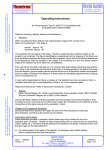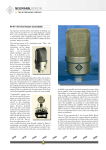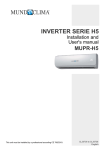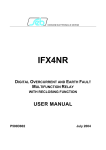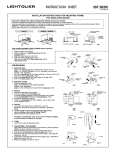Download Operating Instructions for Flame -Detector FL(Ex)d
Transcript
Operating Instructions for Flame -Detector FL(Ex)d 883FT...J Rules for mounting, starting, testing, maintenance, repairsand hints on troubles 1. Mounting When mounting the flame detector the optical location angle has to be observed. The location angle is vertical approx. 90° to 100° horizontal approx. 90° to 100° The sensitivity will decrease to the sides. Therefore adjust the flame detector directly to the project to be monitored. The flame detection is depending of the intensity of the flame, the distance between flame and flame detector. Due to this fact, the flame detector has to be mounted close to the project. For monitoring of a room the optical location angle of the detector has to be observed. If the unit will be mounted in the open air or in covered halls (petrol depot monitoring, gas stations etc.) it has to be observed that flames of the flare of excess gas also if the flames are far away, gas and welding flames, and the Electric arcs of electric welder and electric trains can cause a release of the detector. If these cases the sensitivity adjustment has to be disputed prior to mounting of the unit. In room with contaminated air (dusty or greasy air) the detector has to be mounted so, that it is ventilated with fresh air to avoid depositing of dust or oil on the inspection glass. Attachment dimensions: Refer to Dimension Drawing No. 3.3036.3 and Drawing No. 3.4315 for swivel bracket 2. Starting Connect the detector corresponding to the cable marks of the terminal box and adjust to the object to be monitored. Check 24 VDC power supply and signal lines. 3. 3.1 Functional Test Voltage Monitoring/Failure After connection of the 24 VDC corresponding to the connection diagram gets the failure relay K2 energized in the undisturbed state. The change-over contact opens the connection terminal 3 - 4 and closes 3 - 5. 3.2 Fire Alarm Flame detectors mounted in an explosion area may only be tested by use of an explosion-proof UV-tester. Outside of the explosion area an open flame can be used for testing (matches, gas lighter etc.). Adjust the UV-tester to the detector to be checked can switch in the tester. The time till giving alarm is depending of - the intensity of the UV-radiation (tester or flame) - the distance between radiation source and detector - the response sensibility of the detector (delay of fire alarm signal) - the contamination of the optic (if necessary clean before test) The relay K1 will be actuated in case of fire alarm. The change-over contact opens terminal 6 - 7 and closes terminal 6 - 8. Simultaneously the red LED of the reflector lights up. 3.2.1 Reset of Fire Alarm Signal Date: 03/86 Version: 0 4.0254 Page 1 of 4 If the alarm of the detector is according to vote with the manufacturer set on continuous alarm, reset can be effected only by short disconnection of the 24 VDC power supply (e.g., by an external reset push button). As long as this reset will be actuated, there will be given a failure signal. If the alarm of the detector is according to vote with the manufacture set on time-limited alarm, reset of the alarm will be automatically after run down of the adjusted time. 3.2.2 Manual Test (by the integrated test electronic of the detector) and functional Test Connect the +24 VDC of the detector via a push button (normal open contact) to terminal 9. By actuating of the push button is the test electronic switched on. Functional sequence: see attached description. ATTENTION ! Never open an explosion-proof flame detector in an explosion area due to explosion danger!. Be careful when working on an open and connected detector! The terminals of the UV-vacuum tube have a voltage of approx. 600 V! 4. a) Maintenance In dusty atmosphere The quartz glass should be clean, so that at optical check the reflector and the UV-vacuum tube are visible. Otherwise clean the inspection glass by means of a soft grease-free cloth. If necessary clean the exit of light of the photoconductor cable. b) In greasy atmosphere No oil may be deposit on the glass, because a thinn oil film can influence the sensibility of the detector. Therefore clean the glass more often by means of a soft and grease-free cloth, respect. clean the glass by means of a grease solvent, and clean the exit of light of the photoconductor cable and the glass for the UV-emitter. Condensed water on the glass causes only a little influence to the sensitivity of the detector. c) Electronic The evaluation electronic is generally maintenance -free. The UV-vacuum tube UVN 81 should be checked at least every 2 years, and it is recommended to replace the tube every 4 years. The DC/DC-transformer DC 880 generates the power supply for the UV-vacuum tube of 600 V +/- 5 % which can be checked by means of an oscilloscope (input resistance 20 MOhm) at pin 8. The DC/AC-transformer 883-T generates the power supply for the UV-emitter which can be checked by means of an oscilloscope (input resistance 20 MOhm) at pin 4. The operating voltage for the UV-emitter is 250 V Ws (ignition voltage 700 V Ws). The time of life of the UV-emitter TE 883 is depending of the test time and test sequence andis at 1 test per hour (6 sec.) approx. 3 years. A reduction of the UV-radiation capacity or a defekt at the DC/AC-transformer will be indicated by a longer time between test release and alarm signal or under certain conditions that the failure counter on the evaluation board will be released and with this a failure signal is given, even if the optic has been cleaned and the photoconductor cable has been adjusted correctly. 5. Repairs Never open an explosion-proof flame detector in the explosion area, due to the Date: 03/86 Version: 0 4.0254 Page 2 of 4 explosion danger! Repairs may only be carried out from persons who are conversant with the rules for explosion areas! Be careful at tests on the opened and connected detector, because the terminals for the UV-vacuum tube and the DC/DC-tansformer DC 880 and DC 883-T have a voltage of approx. 600 V! Opening of Housing Unscrew cover screws with wrench for socket heas cap screws and remove spring rings from the srew guides. Then turn cover for 90 degrees and pull off without use of tools or without canting (to avoid damages of gasket surface and gaskets) from the lower part of the ousing. Removal of the cover is sometimes not so easy, because when pulling off the cover the under pressure must be conquered. Do not remove the gasket grease. Closing of Housing Prior to insert of the cover clean the glass by means of a clean and grease-free cloth respect. clean with grease solvent, and if necessary grease the gaskets by means of not easily inflammable grease. Insert the cover without canting into the lower part of the housing. The underpressure will be conquered by tightening of the screws. Replacement of Components/Order of Spare Parts In case of spare parts order the following data must be given: 1. Type and serial number of the flame detector 2. Type of the electronic unit or assy according to wiring diagram. For safety reasons the repairs should be limited to following components: 1. Fuse F1, M 0,2 A, 250 C 2. UV-vacuum tube UVN 81 3. LED in the reflector 4. Evaluation board Type Ex-S 880a 5. Test board Type TFP 883 6. UV-emitter Type TE 883 7. Relay board Type Ex-S 883 RB The coder units BU1 and BU2 on the evaluation board and BU3 on the test board may be replaced only after consultation of the manufacturer and according to instructions. 6. Hints on Troubles and Signaling General Signalings Signal output: Voltage monitoring/failure Relay K2 The relay is normally energized and drops out if a) the 24 V supply has a breakdown b) the fuse of the detector is defective c) the internal 15 V supply is faulty or similar d) the voltage generation of the DC/DC-tansformer has a breakdown e) the automatic test is faulty f) the failure counter signal is given. Signal output: Fire Alarm Relay K1 The relay gets energized at fire alarm Date: 03/86 Version: 0 4.0254 Page 3 of 4 LED of reflector LED lights up a) as long as fire alarm is signalled b) short light up for approx. 0,1 sec, after finish of automatic test c) continuous light up when failure counter signal is given Hints on trouble shooting 1. At signal: "Failure" and LED in detector lights up. Cause: Failure counter has released. Reset can be effected by short disconnection of power supply. Possible Cause: Defective UV-vacuum tube defective evaluation electronic very low UV-radiation due to far flame Check: Switch off voltage for the detector shortly. If the failure comes on again after some time (approx. 10 min. to 24 hr. or longer) replace UV-vacuum tube and check evaluation electronic 2. At Signal "Failure" Possible failure: Switched off 24 VDC power supply defective fuse F1 defective electronic test failure Check: Switch off shortly power supply for detector. If the failure signal is still on check electronic and voltage. If the failure comes on again after min. 15 sec., check the optic of the detector for contamination, and check the function of the UV-emitter and the test electronic. If the detector is further on in operation after a test fault, this failure will be reset automatically after run down of the time interval and indicated again after min. 15 sec. 3. If the detector does not give an alarm at manual test or functional check with an explosion-proof UV-tester, check electronic and UV-vacuum tube. Date: 03/86 Version: 0 4.0254 Page 4 of 4





